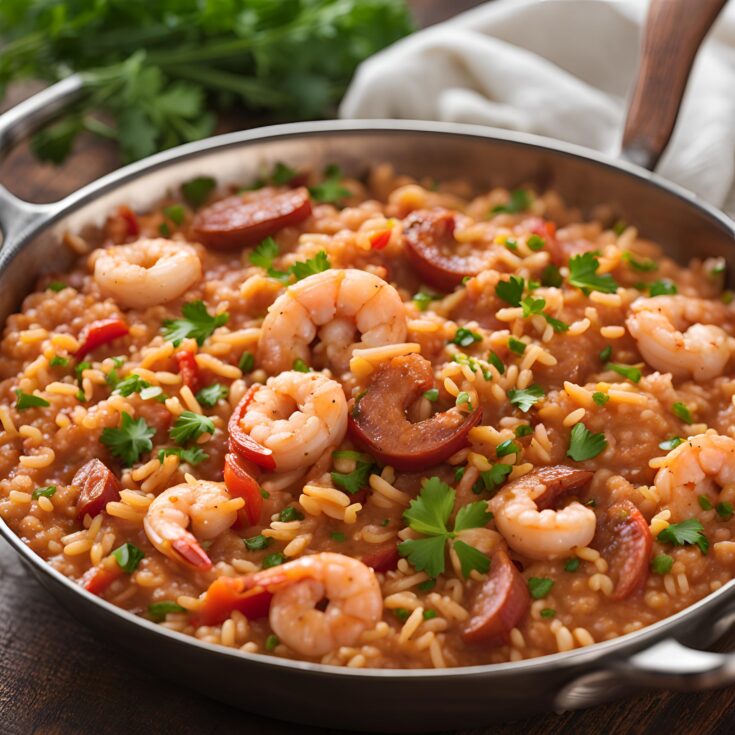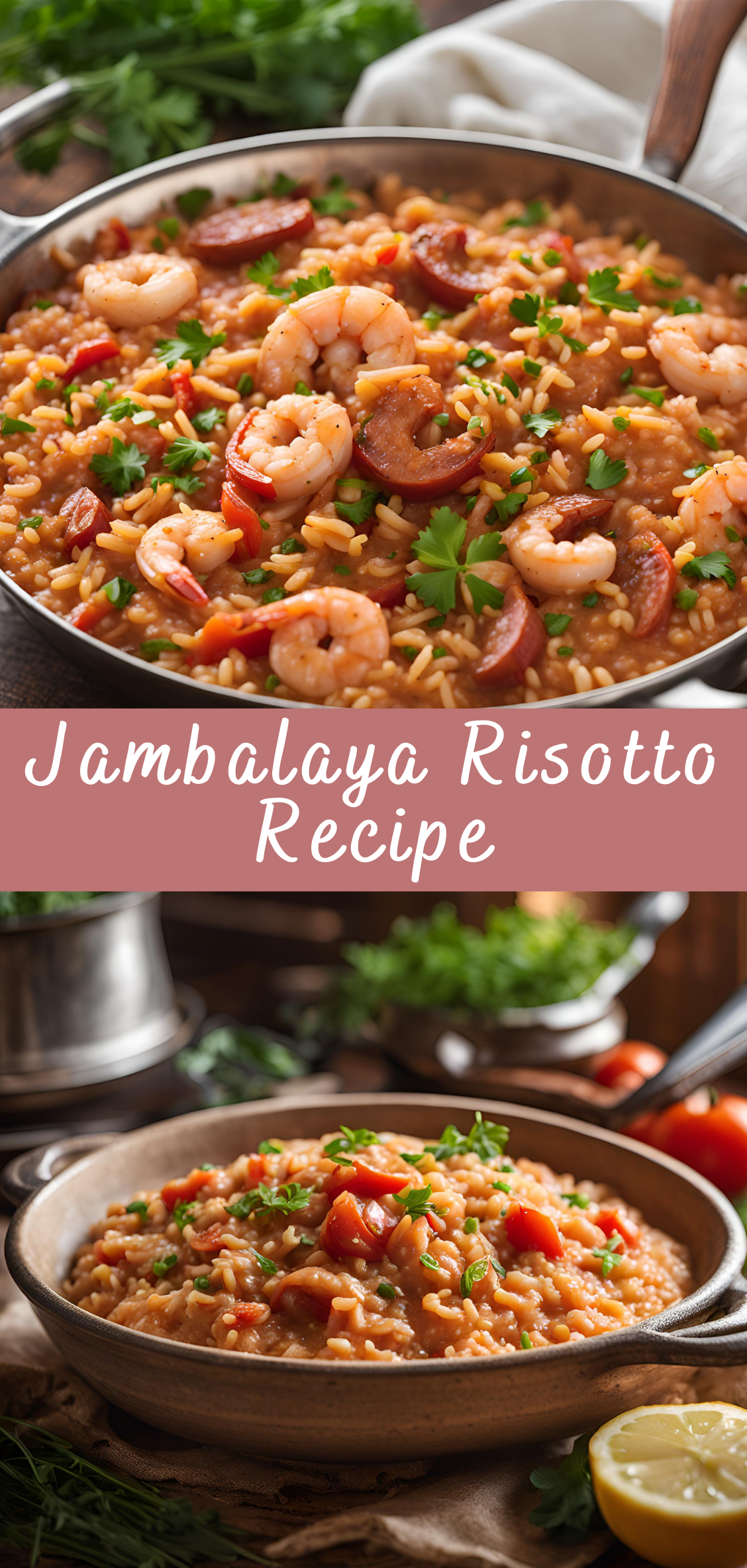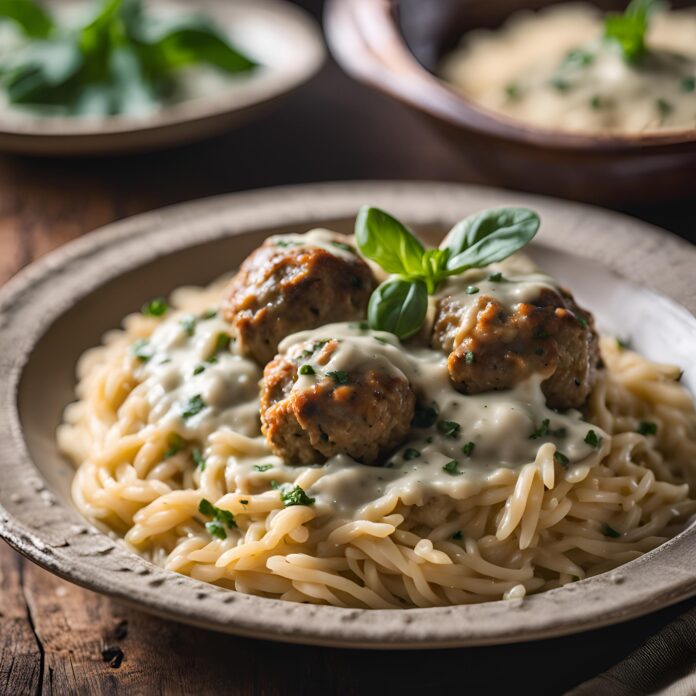Jambalaya Risotto Recipe
Jambalaya Risotto is a delicious fusion of the classic Italian dish, risotto, and the bold, flavorful elements of Cajun cuisine found in jambalaya. This dish brings together creamy Arborio rice, succulent proteins, and a medley of vibrant spices, resulting in a comforting and satisfying meal that pays homage to both culinary traditions. Whether you are looking to impress guests or simply enjoy a hearty dinner at home, Jambalaya Risotto is an excellent choice.

The beauty of Jambalaya Risotto lies in its versatility. You can customize it based on your preferences, incorporating various proteins such as chicken, shrimp, and sausage, while also adjusting the heat level with spices. This dish combines the creamy texture of risotto with the robust flavors of jambalaya, making it a delightful experience for your taste buds.
Step-by-Step Preparation
Now that we have a good understanding of the ingredients, let’s dive into the preparation of Jambalaya Risotto. This section will guide you through each step, ensuring that you achieve the perfect balance of flavors and textures.
Preparing the Proteins
Begin by preparing your proteins:
- Chicken: Dice boneless, skinless chicken thighs or breasts into bite-sized pieces. Season them lightly with salt and pepper. In a large skillet or saucepan, heat a tablespoon of oil over medium-high heat. Add the chicken and sauté until it is golden brown and cooked through, about 5-7 minutes. Remove the chicken from the pan and set it aside.
- Andouille sausage: Slice the andouille sausage into rounds or half-moons. In the same pan, add a bit more oil if needed, and sauté the sausage until it is browned and crispy, about 3-4 minutes. Remove the sausage from the pan and set it aside with the chicken.
- Shrimp: If using raw shrimp, peel and devein them, leaving the tails on if desired. Lightly season the shrimp with salt and pepper. Set aside to be added later in the cooking process.
Sautéing the Vegetables
Next, focus on building the flavor base with the vegetables:
- Heat the oil: In the same skillet, add a tablespoon of olive oil and heat over medium heat. This will allow you to incorporate all the flavors left in the pan from the proteins.
- Cook the onions: Add diced onions to the skillet and sauté for about 3-4 minutes until they become translucent and fragrant.
- Add garlic, bell peppers, and celery: Stir in minced garlic, diced bell peppers, and chopped celery. Continue to sauté for an additional 4-5 minutes until the vegetables are softened and aromatic.
- Add spices: Sprinkle in your Cajun seasoning, and add bay leaves and a pinch of salt and pepper. Stir well to ensure the spices coat the vegetables evenly, releasing their flavors.
Incorporating the Rice
Once the vegetables are softened and seasoned, it’s time to add the Arborio rice:
- Toast the rice: Add the Arborio rice to the skillet and stir it well with the vegetables. Toasting the rice for about 2 minutes helps to enhance its nutty flavor and ensures each grain is coated in the oil and spices.
- Deglaze with tomatoes: Pour in a can of diced tomatoes with their juices, scraping the bottom of the pan to release any browned bits. This step will add acidity and richness to the risotto.
Gradually Adding Stock
The next step is crucial for achieving the creamy texture that risotto is known for:
- Add stock: Begin by adding a ladleful of warm chicken or vegetable stock to the rice mixture. Stir gently and allow the rice to absorb the liquid. Continue to cook over medium heat.
- Continue adding stock: Once the stock is mostly absorbed, add another ladleful. Repeat this process, stirring frequently and adding stock gradually. This technique releases the starches from the rice, creating a creamy consistency. This process typically takes about 18-20 minutes.
Cooking the Proteins
As the risotto cooks, it’s time to finish preparing the proteins:
- Add the chicken and sausage: When the rice is nearly cooked through and the consistency is creamy, stir the cooked chicken and sausage back into the pan. Allow them to warm through, about 3-4 minutes.
- Add the shrimp: Finally, gently fold in the seasoned shrimp, and cook for an additional 3-5 minutes until the shrimp are pink and cooked through. Be careful not to overcook the shrimp, as they can become rubbery.
Finishing Touches
Now that everything is combined, it’s time to finish the risotto:
- Add cream: For extra creaminess, you can add a splash of heavy cream or a pat of butter. Stir until melted and combined.
- Adjust seasoning: Taste the risotto and adjust seasoning as needed with additional salt, pepper, or Cajun seasoning.
- Garnish: Remove the bay leaves and discard them. Sprinkle chopped fresh parsley and sliced green onions on top for a burst of color and freshness.
Serving Suggestions
Jambalaya Risotto is a complete meal in itself, but you can serve it with some complementary side dishes to elevate the dining experience:
- Crusty Bread: Serve with slices of crusty French bread or garlic bread to soak up the delicious sauce.
- Salad: A simple green salad with a light vinaigrette can provide a refreshing contrast to the rich and creamy risotto.
- Wine Pairing: Pair with a chilled white wine like Sauvignon Blanc or a light red wine like Pinot Noir, both of which can enhance the flavors of the dish.
Storing and Reheating
If you find yourself with leftovers (though it’s hard to resist this delicious dish), storing and reheating properly is essential:
- Refrigeration: Allow the risotto to cool completely, then transfer it to an airtight container. It will keep well in the fridge for up to 3 days.
- Reheating: When reheating, add a splash of broth or water to the risotto to loosen it up, and warm it in a skillet over low heat, stirring frequently to prevent sticking.
- Freezing: While risotto is best enjoyed fresh, you can freeze it. Portion out the risotto into freezer-safe containers, and it will keep for up to 2 months. Thaw in the fridge overnight before reheating.
Customization Options
One of the best aspects of Jambalaya Risotto is its versatility. Here are some ideas for customizing the recipe to suit your taste:
- Vegetarian Version: For a vegetarian jambalaya risotto, omit the meats and add more vegetables such as zucchini, mushrooms, or corn. You can also incorporate protein-rich legumes like chickpeas or lentils for added texture and flavor.
- Spice Level: Adjust the heat level by using less Cajun seasoning or adding a dash of hot sauce to the risotto. If you enjoy a spicy kick, consider incorporating diced jalapeños or a sprinkle of crushed red pepper flakes.
- Seafood Variation: For a seafood jambalaya risotto, include a variety of seafood such as scallops, crab, or fish fillets. Adjust the cooking time accordingly to ensure the seafood is cooked perfectly.
- Cheesy Risotto: Add shredded cheese such as Parmesan or a spicy pepper jack for a cheesy twist. Stir in the cheese just before serving for a gooey, indulgent finish.
Conclusion
Jambalaya Risotto is a celebration of flavors that brings together the best of Italian and Cajun cuisine. The creamy Arborio rice, combined with savory proteins and aromatic spices, creates a comforting and satisfying dish that will please any palate. Whether you’re cooking for a special occasion or a cozy family dinner, this recipe is sure to impress.
With its adaptability and ease of preparation, Jambalaya Risotto is a dish that invites creativity in the kitchen. Feel free to experiment with ingredients and make it your own. Serve it hot, garnished with fresh herbs, and enjoy the delightful fusion of flavors that makes this dish a true culinary masterpiece.
Jambalaya Risotto Recipe

Jambalaya Risotto is a delicious fusion of the classic Italian dish, risotto, and the bold, flavorful elements of Cajun cuisine found in jambalaya. This dish brings together creamy Arborio rice, succulent proteins, and a medley of vibrant spices, resulting in a comforting and satisfying meal that pays homage to both culinary traditions. Whether you are looking to impress guests or simply enjoy a hearty dinner at home, Jambalaya Risotto is an excellent choice.
Ingredients
- 1 tablespoon olive oil
- 1/2 lb (225g) andouille sausage, sliced
- 1/2 lb (225g) boneless, skinless chicken thighs, diced
- 1/2 lb (225g) medium shrimp, peeled and deveined
- 1 small onion, diced
- 1 small green bell pepper, diced
- 1 small red bell pepper, diced
- 2 cloves garlic, minced
- 1 1/2 cups arborio rice
- 1/2 teaspoon smoked paprika
- 1/2 teaspoon cayenne pepper (optional, for heat)
- 1/2 teaspoon dried thyme
- 1/2 teaspoon dried oregano
- Salt and black pepper, to taste
- 4 cups chicken broth, warmed
- 1/2 cup diced tomatoes (canned or fresh)
- 1/2 cup grated Parmesan cheese
- 2 tablespoons butter
- Fresh parsley for garnish
Instructions
1. Sauté the Sausage and Chicken:
- Heat the olive oil in a large skillet over medium heat. Add the sliced andouille sausage and cook until browned, about 3-4 minutes. Remove the sausage from the skillet and set aside.
- In the same skillet, add the diced chicken and cook for 5-6 minutes until browned and fully cooked. Remove and set aside with the sausage.
2. Cook the Shrimp:
- Add the shrimp to the same skillet and cook for 2-3 minutes, until they are just pink and cooked through. Remove and set aside with the sausage and chicken.
3. Sauté the Vegetables:
- In the same skillet, add the diced onion, bell peppers, and garlic. Cook for 3-4 minutes until softened and fragrant.
4. Toast the Rice:
- Add the arborio rice to the skillet with the vegetables. Stir frequently for 2-3 minutes, allowing the rice to absorb the flavors and become slightly toasted.
5. Add the Spices and Begin Cooking the Risotto:
- Stir in the smoked paprika, cayenne pepper (if using), dried thyme, oregano, and season with salt and black pepper.
- Start adding the warm chicken broth, one ladleful at a time. Stir frequently, allowing the liquid to absorb before adding more. Continue this process until the rice is tender and creamy, about 20-25 minutes.
6. Add Tomatoes and Protein:
- Once the rice is nearly done, stir in the diced tomatoes. Add the cooked sausage, chicken, and shrimp back into the skillet. Cook for an additional 3-4 minutes, allowing everything to heat through.
7. Finish with Parmesan and Butter:
- Stir in the grated Parmesan cheese and butter, mixing until everything is creamy and well combined.
8. Serve:
- Garnish with fresh parsley and serve hot.
Notes
- Customize Your Protein: Feel free to adjust the protein. Substitute chicken thighs with chicken breasts or add extra shrimp if preferred.
- Spice Level: Adjust the amount of cayenne pepper based on your preferred level of heat.
- Make It Ahead: The sausage and chicken can be cooked ahead of time, making the final dish quicker to assemble.



